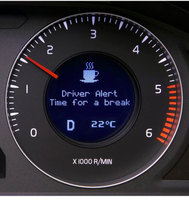Volvo launches technology to alert tired and distracted drivers
 Studies show that up to 90 per cent of all traffic accidents are caused by driver distraction and, based on these high statistics, Volvo is focusing on developing efficient technology to help a driver avoid or reduce the severity of accidents caused by distraction or driver fatigue. Volvo is introducing a world-first technology, the Driver Alert Control (DAC) as well as a Lane Departure Warning (LDW) system at the Frankfurt Motor Show in September. These two systems will be available as an option priced at £500 on the all-new Volvo V70 and XC70 and the Volvo S80 at the end of 2007.
Studies show that up to 90 per cent of all traffic accidents are caused by driver distraction and, based on these high statistics, Volvo is focusing on developing efficient technology to help a driver avoid or reduce the severity of accidents caused by distraction or driver fatigue. Volvo is introducing a world-first technology, the Driver Alert Control (DAC) as well as a Lane Departure Warning (LDW) system at the Frankfurt Motor Show in September. These two systems will be available as an option priced at £500 on the all-new Volvo V70 and XC70 and the Volvo S80 at the end of 2007.“Real life safety is the key to our safety philosophy. When it comes to preventative safety, we have the same approach as when we develop protective systems. In other words our research and technical developments focus on areas where new technology can create significant results in real-life-traffic,” says Ingrid Skogsmo, Director of the Volvo Cars Safety Centre.
A unique innovation
By undergoing extensive studies of how drivers operate behind the wheel, Volvo has developed Driver Alert Control (DAC) a world first innovation. Rather than monitoring human behaviour (which varies from one person to another) DAC monitors the progress of the car on the road. Monitoring driving behaviour is more reliable as it assesses the impact that fatigue or distraction has on the car’s movements and assesses whether it’s being driven in a controlled, consistent manner.
This also means that DAC covers a wider range of situations, such as when the driver is focusing too much attention on a mobile phone conversation or distraction by passengers in the car.
This system consists of a camera located between the windscreen and the interior rear view mirror, a number of sensors and a control unit. The camera measures the distance between the car and the road lane markings, while the sensors register the car's movements. This information is sent to the control unit which then calculates whether the driver is at risk of losing control of the car.
Risk Assessment
If the risk is assessed as high, the driver is alerted via an audible signal, while a text message and coffee cup symbol appear in the car’s information display to urge the driver to take a break. The driver has the opportunity to access driving information throughout a journey, the starting point is five bars and the less consistent the driving, the fewer bars remain.
“It is, of course, always the driver’s responsibility to take a break when necessary, but sometimes you might not realise that you’re not alert enough to drive. In such situations, Driver Alert Control can help the driver make the right decision before the concentration level becomes too low,” concludes Daniel Levin, project manager for Driver Alert Control at Volvo Cars.
Changing Lanes
Volvo Cars’ researchers estimate that the Lane Departure Warning (LDW) system can help to prevent 30 to 40 per cent of accidents caused by single car road departures and head-on collisions. LDW uses the camera located between the windscreen and the rear view mirror and monitors the car’s position between the road markings. The system is activated via a button on the centre console and gives a gentle warning sound if the car crosses one of the road markings without reason such as if the indicator hasn’t been used.
Both the Driver Alert Control and Lane Departure Warning are activated when the car reaches 40mph and they will stay active as long as the speed exceeds 37mph. The availability of these systems depends on the number and quality of visible road markings. The lane markings must be clearly visible and poor light, fog, snow and extreme weather conditions can make the system unavailable.

